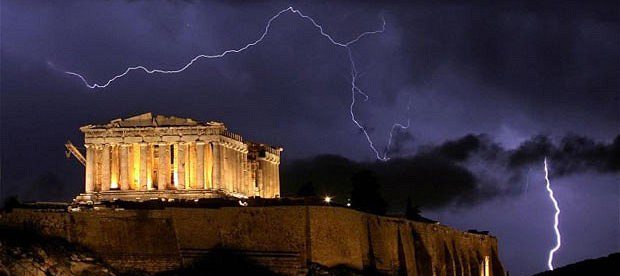Witches & Witchcraft in Aberdeen
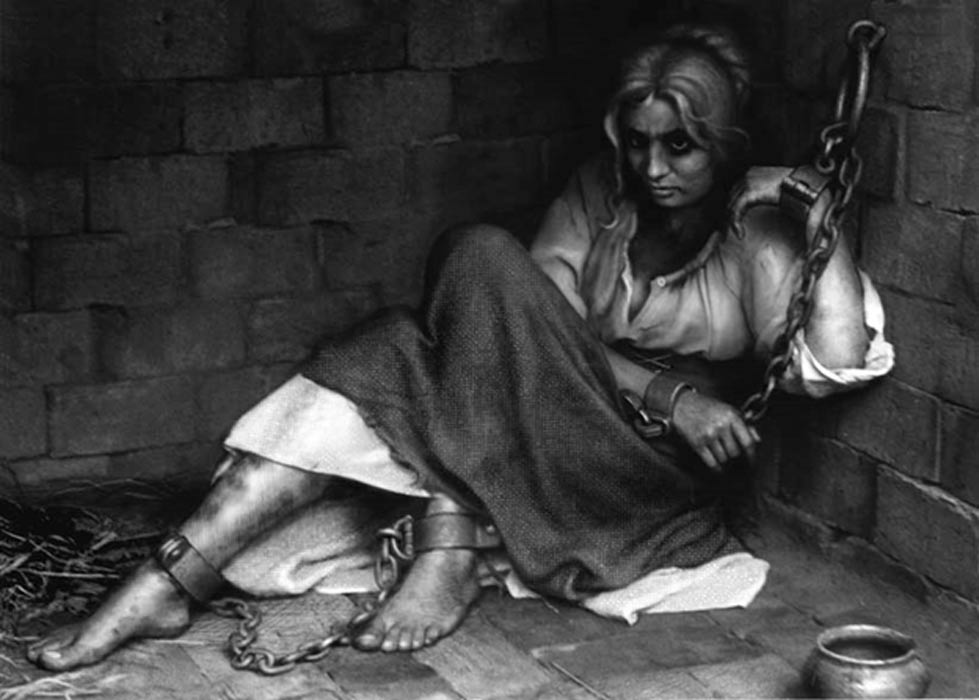

Who were the Witches? Witches & Healers had existed & been accepted as Members of Society for Centuries. During the later years of the 16thC, though, it was commonly believed that these people received their Power from the Devil. The Essence of Witchcraft was held to be entering into a Pact with the Devil, rather than the Deeds, good or bad, which could be attributed to a Witch. Women were most likely to be accused of Witchcraft: 80% of Cases Recorded in Scotland involved women. In Aberdeen and the surrounding areas during 1596 & 1597 2-men & 45-women were charged. These women were often the Poor, elderly women of a Community ‘whose poverty, sour temper or singular habits made them an object of dislike or fear to their Neighbours’. Such a woman might or might not have a reputation for Healing, as well as harming, but above all else, she was deemed to have malevolent Supernatural Powers. Some of the most common misfortunes for which Witchcraft was deemed responsible were sudden illness, certain accidents, lingering illness for which no cause was clear, strokes, unexpected deaths, failure of Crops (especially if others were doing well), strange behaviour in Animals & Disasters at Sea.
Influence of the Church
Prior to 1563, Witchcraft was deemed a Crime in Ecclesiastical Law. The belief that Individuals could make a face-to-face Pact with the Devil & pay Homage to him in Nocturnal gatherings, led to theories of Diabolical Conspiracy, thus providing the intellectual foundation for Witch Hunts in which the Catholic Clergy played a part. After the Reformation, the Protestant Ministers & Elders of individual Parishes were actively involved in the initial Interrogation of Suspects & through their role as Members of the General Assembly, applied constant pressure on the Government to establish a Godly Sate through seeking out & Prosecuting those believed to be in Communion with Satan.
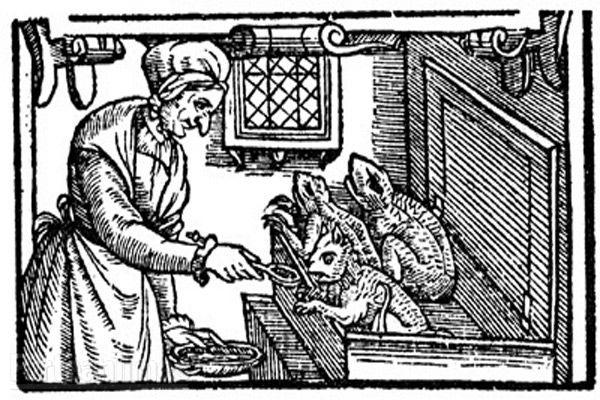

Influence of James VI:
In 1590 James VI presided over a Witchcraft Trial in North Berwick. This very high profile Trial reinforced the existing anti-Witch Sentiments of the time and sparked a wave of similar Trials throughout Scotland in the 16th & 17thCs. At least 3,837 people were Accused of Witchcraft. Many of these were Tortured and up to 70% were put to Death. It is thought that William Shakespeare wrote his famous play Macbeth when James became King of England. It is a Tale of Witches, Scottish Kings & Murderous Plots.
James VI paid several Visits to Aberdeen, viz. in 1582, 1589, 1592, 1594 & 1600, and, generally speaking, these Royal Visits were expensive affairs to the Citizens, both in Entertainments & in Presentations of Money given to his Majesty, according to the Custom of the time. About this time, the Crime of Witchcraft was supposed to be prevalent in Aberdeen as well as in other parts of the Kingdom & many poor old women were sacrificed to appease the terrors which the belief in it was calculated to excite. Few of the individuals who were suspected were allowed to escape from the hands of their Persecutors; several died in Prison in consequence of the Tortures inflicted on them & during the years 1596-97, no fewer than 22 were Burnt at the Castle Hill.
In 1563 the Queen’s Act against Witchcraft was introduced in Scotland. The Act stated that no person should ‘use any manner of Witchcraft, Sorcery or Necromancy, nor give themselves forth to have any such Craft or Knowledge thereof‘. The Penalty for being Convicted as a Witch was Death. There followed 2-Main Periods of Witch Persecution in Scotland, the 1st of which was in the 1590‘s & the 2nd in the 1640‘s. The late-16thC craze was encouraged by the Return Journey of King James VI and his wife from Denmark when bad weather put the Convoy of Ships at Risk. One of the King’s attendant Ships was Lost & it was widely believed that the High Winds were caused by a number of Witches assembled at North Berwick Church & in Copenhagen. Many were made following rumours of a Conspiracy between the Witches of the 2-Countries against the King. Whilst James VI was in Denmark he was influenced by discussions about Witchcraft & Witch-hunting which had already begun in that Country. His power to influence had a major effect on the number of Witch Persecutions & in 1596 & 1597 the highest ever figures for Persecutions were recorded. His views quickly permeated to the Ruling Classes & the Clergy. James insisted that all Witches, all Ages, all Ranks & even bairns deserved Death by Fire.
One of the 1st things James did, after he became King of England in 1603, was to have his Demonology Republished. Another of his Initial Actions as the English Monarch was to revise the Witchcraft Statute of England, by making its Penalties much more severe than was the case with the old Witchcraft Act that had been in use under Elizabeth I. Crimes that had been Punishable by a Term of Prison became, under James, Punishable by Death. It was all part of his personal Holy Crusade against Witchcraft. He saw himself as the White Knight of the Biblical Book Revelation, Terror of Witches & Scourge of the Devil who wielded a Flaming Sword of Punishment with which he dispensed Justice across the World. As he had done to Witches in Scotland, so he intended to do in England.
Aberdeen Wichcraft
In Aberdeen, those Accused of Witchcraft were Committed to Ward as Suspect & Guilty of ‘Witchcraft, Sorcery & other Diabolical & Detestable practices‘. The Justice Court, which presided over these Trials, consisted of the Provost of Aberdeen, 4-Baillies & a Jury. The Trials were held in the Tolbooth.
Dittays – lists of Charges against a Witch read out before the Court – often went back 25-30 yrs & included Accusations from neighbours & occasionally, Family members. The ‘Dittays’ were compiled as the 1st Step in bringing Witches to Trial. At the Trials Witnesses would Testify to seeing or being involved in certain events corresponding to the Charges listed. Many of the Dittays were written to a common formula & contained dates & times of day when Acts of Witchcraft supposedly happened. The Accusations are nearly all concerned with a Curse or Casting a Spell. As a result of the Spell, untoward things happened to those Cursed Families, Homes or Animals. There are many fascinating accounts relating to the Trials of the women & the few men, who were both accused & tried for Witchcraft & Sorcery within the Burgh of Aberdeen & the surrounding areas.
16thC – Aberdeen Witch Trails of 1596-97, The Names of the Witches & their Crimes
Aberdeen Town Council had its own shameful Record of Witchcraft Persecutions. Between February 1596 & April 1597, 23-women & 1-man were Tried & Convicted. The Guilty were 1st Hanged & then Burned on the Heading Hill. The Town’s Hangman had a Set Fee, £1-6s-8d & for that 4-Witches were Killed in a single day. Petty Criminals were Hanged, Traitors were Beheaded on ‘Heading Hill‘ which was above where the old Commerce Street School Site is today. The surviving Route to ‘Heading Hill’ led down from Castle Terrace via Hanover Street, or Justice Street or via Castle Hill Cast-Iron Bridge now removed.
The identity of the Spirit allegedly encountered by a man Tried in Aberdeen in 1598. The Trial Dittays Record that: Thow confessis that the Devill, thy Maister, quhom thow termes Christsonday & supponis to be ane Engell & Goddis godsone, albeit he hes a thraw by God & swyis to the Quene of Elphen, is rasit be the speking of the word Benedicte
Margaret Clarke of Lumphanan– accused of the death of John Burnett. As he rode by on Horseback she ‘lurkit back towards him & cast up her hands and mumbled some of her ‘Devilish Prayers’. He took to his bed & died.
Janet Davidson of Sundayswells, said to have killed Patrick Hunter with her ‘diverse Writings of Witchcraft’
Helen Rogie of Findtrack, she specialised in making ‘pictours’ of her intended victims. (a pictour is a image made from soft Lead or Wax or other material). At her Trial, it was described how ‘she roasted sundry times the pictours of men whome thou murdered’.
Margret Ogg was said to have Bewitched her neighbour’s Cattle.
Janet Lucas was found to have a Magical Charm of coloured thread in her purse when arrested at the Kirk in Lumphanan.
Isobel Ogg of Craigtown of Lumphanan was Indicted for using Witchcraft so that 2-Banchory women could outsell their rivals at Market.
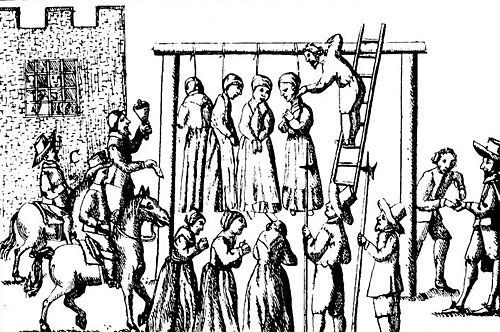
Fire Burn & Cauldron Bubble 1597:
The late-1500s were a turbulent time, & many were suspected and accused of being Witches. Men & women were put on Trial for various reasons.
One of the most interesting cases in Aberdeen happened in 1596 and concerned a whole Family. The mother, Jane Wishart, was brought to Trial and eventually Convicted on 18-points of Witchcraft, although the total number of Charges brought against her exceeded 30 & covered a period of over 20-yrs. The Charges included casting a Spell on a Fisherman who then took to his bed & ‘lay bed sick for one month‘. The earliest Charge related to an incident when 5-men caught her coming out of the Yard of Adam Mair, one of her neighbours, at 2 in the morning. The men woke up Adam’s wife to tell her what they had discovered & later that day at about 2 or 3 o’clock in the afternoon, 2 of the men were found Drowned in the Auld Wattergang at the Links (stream channel especially when constructed artificially as for land drainage or irrigation) where they had gone to Wash. Two others who had seen Janet leave her neighbour’s House subsequently offered the Testimony against her. Janet’s son-in-law, John Allan Testified against her following an incident when he hit his wife & was chastised by Janet. Following this, a brown dog started to come into his Bedroom & attack him, although it left his wife alone. This continued until John threatened to complain to the Minister & the Kirk Session. Eight days before Janet was apprehended there was heard a rumbling noise in her House which frightened her next door neighbour who thought his House might fall over. This, too, was attributed to Janet’s Supernatural Powers & formed one of the Points of Witchcraft on which she was Convicted.
Janet’s son, Thomas Leyis, was found Guilty of being a Ringleader & convicted on 3-Accounts of Witchcraft. He is said to have presided at a meeting held at midnight in the Castlegate when many Witches convened at the Mercat & Fish Cross ‘under the conduct & guiding of the Devil present with them‘. These people all danced & played instruments about the Crosses & Thomas was accused of being foremost amongst them & of hitting Kathren Mitchell ‘because she spoilt the Dance & ran not so fast as the rest‘. Both Janet & Thomas were Strangled & Burnt as the, following Accounts show.
“Item, the xxiii. Of Februar, 1596, for peatis, tar barrellis, fir and cillis, to burne the said Thomas [Leyis], and to Jon Justice, for his fie in Executing him, £3-13s-4d.”
On the 22nd of March the same year John Leyis (Janet’s husband) & their 3-daughters, Elspet, Janet & Violet were also accused of Sorcery. They were absolved on all Counts of Witchcraft but found Guilty of being in the company of Janet & Thomas & acting as their Accomplices. As a result, they were Banished from Aberdeen & the surrounding area and were forbidden to come within 10-miles of the Burgh.
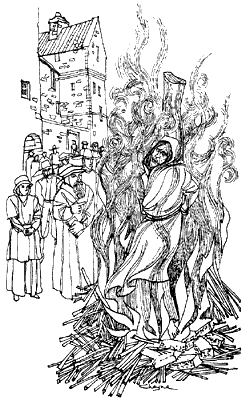
Unfortunately, the Dittays for each of these Trials no longer exist but Aberdeen’s City Archives do still have the original Dittay for the Trial of Isobel Strathanchyn. A list of charges of Witchcraft brought against Isobel Strathanchyn or Scudder. She faced a number of Charges & the image highlights just one of them. Along with creating a Love Potion, she is also accused of breaking the Wheels of a Mill in revenge after the Miller had refused to give her any Meal. It is also alleged that she took the Bones of the dead from the Kirkyard at Dyce. Another accusation against her was that she had managed to cure diseased Sheep in Gartly by using Witchcraft. Isabel was found Guilty & sentenced to Death. Other records in the City Archives detail what was used to carry this out. She was found Guilty of Witchcraft & burned in March 1597.
Transcription & Translation of Charge Two in the Dittay Given Against Isobel Strathanchyn, February 1597
Secundlie thou are art Indyttit for cu[m]ming to Elspet Mutray in vodheid vodes and askng fra hir to len the a pennie, q[ui]lk quhen sche had gevin the, thou tuik the pennie and bowitt it, and than tuik a clout and a piece of reid wax, and sewit the pennie and the wax within the clout, and therefter thow having Inchantit that clout thow gawe it to the said Elpset Mutray, Bidding hir hing the same about hir craig, and quhen sche saw the man sche luffit best, baid hir thin tak the clout w[it]h the pennie and the wax and straik hir face thereft[er] and she sua doing sult atteane to the mariage of the man quhom sche luffit best, and the s[ai]d Elspet understanding that thy said directioun to hir was plane Witchcraft and Devilrie she keist that clout in the fyre, q[ui]lk had almost birnt all hir Hous, and this you can not deny.
Secondly you are Indicted for coming to Elspet Mutray in Woodhead Woods & asking her to lend you a penny, which when she had given you, you took the penny and bent it, then took a cloth and a piece of red wax and sewed the penny and the red wax inside the cloth, and then having Enchanted that cloth you gave it to the said Elspet Mutray bidding her to hang the same about her neck, and when she saw the man she loved best, bade her then take the cloth with the penny and the wax and stroke her face thereafter, and she so doing should attain to the marriage of the man whom she loved the best, and the said Elspet understanding that the said direction to her was plain Witchcraft & Devilry she cast the cloth in the fire, which had almost burned all her house, and this you can not deny
Transcription & Translation of Charge Four in the Dittay Given Against Isobel Strathanchyn, February 1597
Fourlle thou art Indyttit for passing to the Kirk of Dyce and then gathering of a numer of deid folkis Banes, and seything thame in Watter and tacking of That Watter and therefter wasching Willea[m] Sy[m]mer in the Haltoun of Fyntrie (he Than being lyand deidlie seik) and therefter causing the said Willia[m]is gude
Mother tak the saids banes and cast thame in the Watter of Doyn, q[ui]lk
Quhen sche had done, the Watter ru[m]lit in sic a sort as all the Hillis had fallin therin and
this sich you can not deny
Fourthly you are indicted for passing to the Church of Dyce and there gathering a number of dead folk’s bones & boiling them in Water, and taking that Water and thereafter washing William Symmer in the Hatton of Fintray (he then being lying deadly sick) and thereafter causing the said William’s good mother take the said bones and cast them in the River Don, which when she had done, the Water rumbled in such a manner as [if] all the Hills had fallen therein and this you can not deny.
It seems that Isobel & another woman, Katherine Fergus, were executed together. Payments for the items used include £1-12s for 4-Tar Barrels, 6s-8d for 2-Iron Barrels, 13s-4d for the Stake and for someone to carry it and set it up & 6s for 6-Fathoms of Tow, or Rope, which would have been used either to tie them to the Stake inside the Tar Barrels, or to drag them through the Streets before the Execution. 26-Loads of Peat to burn them were paid for at a cost of £2-13s-4d.
17th Century
During the 1630s & 1640s a further wave of Prosecutions for Witchcraft were dealt with in Aberdeen. The City’s Wardhouse, completed in 1629 within the Walls of the existing Tolbooth, housed several Witches awaiting Trial.
On 9th August 1630, a Commission was made to the Sheriff to hold a Court to try Marion Hardie, a vagabond & native of Elgin who had been apprehended in Aberdeen as a suspected Witch. She was examined by the Bishop of Aberdeen as well as the Provost & Baillies & Confessed to several points of Witchcraft. She was then strangled & burnt. The following September, a Commission was made to search for & try, Margaret Lumsden, Mallie Cowper & Marion Rodgie, who had all been implicated in Marion Hardie’s Confession. She had Confessed that she ‘and the persons named came from Fraserburgh in May last & Convened With the Devil at the Water Mouth of Dee beside the Blockhouse, plotted the death of Richard Cadenheid’s Boat in Fittie, cast a number of Stones in the Water Mouth when the Boat was coming in & by their Devilish Enchantments the said Richard & all his Company died, one man excepted. This she Confessed that she, accompanied [by several other named women], being all convened together in one Company at the Devil’s Command by Matthew Wills‘ wife’s instigation, destroyed one Boat belonging to Peterhead wherein there perished or died 12 or 13-persons. All the individuals named were to be apprehended & imprisoned and all were to be examined & the results reported in writing to the Council for further Instructions.
One woman, Margaret Fraser, suspected of Witchcraft in 1636 managed to break Ward & Flee from the Tolbooth. As late as 1650, enquiries were being made in Turriff as to whether ‘Margaret Fraser, Witch, Fugitive from the Province of Aberdeen, has been reset in this Parish. It was reported that she had died.
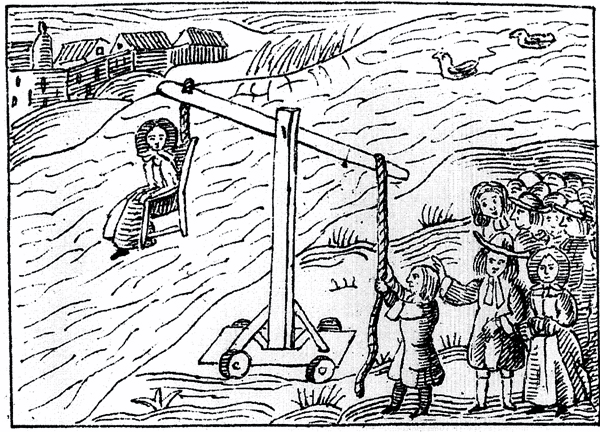
The Cuckstool – The punishment called the Cock or Cuckstool (Cook Stoole) had been early in use in Aberdeen, for the place where it had formerly stood is mentioned in 1320. It was in the South-west of Castle Street on the original Quay near Shore Brae. The Instrument consisted of a Long Beam with a slit in the middle by which it could be turned round in any direction and moved up & down as in the childplay game called “Coup the Ladle.” The Beam was placed on a pin in the top of a post near a Pool or the edge of the Denburn Estuary. A small Chair with Arms was fixed to one end, and the Convict was tied securely into the Chair. The man in charge held a Rope attached to the other end & let the Chair and the Occupant plump into the Water & then he pulled down his end and raised the other. Sometimes several Dips were administered before the Vengeance of the Law was satisfied. There is a sketch of the Instrument in the 1st Edition of “Chambers’s Encyclopaedia.” Scolding Women, Brewsters of Bad Ale & profane Swearers were Dipped at the Cuckstool. Cuck in names is a corruption of the Gaelic word “cnoc,” a Hill. This indicates that the middle of the Beam had rested on a Hillock. There was in old times an Instrument at James Street for loading & unloading Ships with heavy Goods. It could be swung round & loads could be lifted or let down as was required. This was called the Cran, and in the Century 1600-1700, “Ducking at the Cran” was prescribed for the Immoral Females of the Town.

Not all Witches who were accused or brought to Trial were found Guilty and some were actually Acquitted.
Trial by Water – ‘Swimming the Witch‘ – to see if her Guilt could be proven by her ability to Float, or her Innocence assured if she Sank below the surface, was one of the more unusual means by which someone might be acquitted of charges. Some sources tell of Accusations but no Outcomes. The most common Punishments were obviously Strangulation followed by Burning & for the less serious Offences, Banishment. In one Case Isobel Burnett was exempt from the Charge of Witchcraft by the Direction of the King.
The Treasurer’s Accounts for the Execution of ‘Skuddie’ are as follows:
Item, for teuntie sex leadis of peattis to burne thame, 2lib. 13s-4d.
Item, for sex lead of fir 1 lib. 10s.
Item, four tar barrellis, 6s-8d.
Item, for tua irne barrellis, 6s-8d.
Item, for a staik, careing and upsetting thairof, 13s-4d.
Item, for sex fadome of towis, 6d.
Item ,for careing the barrellis, fir and coillis, to the staik, 6s-8d.
Item, to Jon Justice for his fie, 13s-4d.
Item, the xxi. Of March, 1596, gevin to Gilbert Bairnis, be vertew of one Ordinance of Counsall, for satisfaction of the expensis maid be him in sustenatioun of the Witches preceding that dait, induring thair remaining in Prisoun, £2.
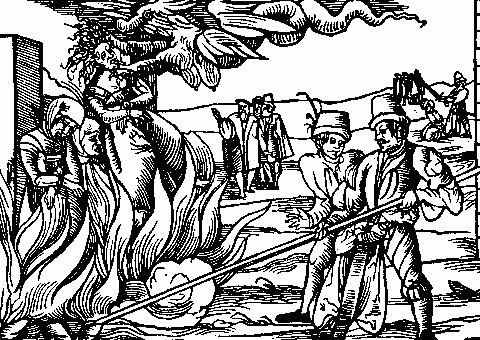
Glossary
assise trial by jury
barrellis barrels
dittay list of charges against a witch
fadome fathom
fie fee
fir fire wood
fyllis find guilty
ime iron
leadis/lead a measure of quantity varying according to district and commodity
lib a pound in monetary terms
merk a monetary unit; 2/3 of a pound of Scots
peatis peat
staik stake
towis a rope, cord or length of strong twine, string
In one busy day at the Justice Court held in the Tolbooth on the 25th April 1597 –
Bessie Paull was charged with Witchcraft
Thomas Ego was charged with using Witchcraft & Sorcery, declared a Fugitive from Justice & had all his belongings confiscated.
Elspett Strathauchyn, of Warthill & Beak Taiss at the Burnside of Logie, were declared Fugitives from the Law ‘Attachit to this day as Witches‘ & had their belongings confiscated.
The Assize absolved Isobel Forbes of Glenmullocht of the charge of Bewitching Gilbert Malcolm & of 2-charges against her.
The Assize absolved Margaret Clerauche of the whole Dittay against her.
John Ross became Cautioner for Elspeth Findlay, at the cost of 200-Merks & for Agnes Frame at a cost of 90-Merks.
Katherine Ferries was convicted as a Rank Witch on 8-points of Witchcraft contained in her Dittay.
In Aberdeen there were quite considerable numbers of Accusations, Trials & Burnings. The total numbers (80) for the years 1536 to 1703 – during which period (177-yrs) Witchcraft was deemed a Criminal Offence in Scotland – for Aberdeen & Aberdeenshire are as follows:
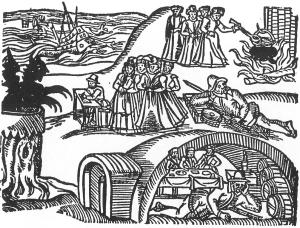
Year Number of cases Year Number of Cases
1536 1 1631 1
1580 1 1636 2
1590 6 1637 1
1596 7 1643 1
1597 31 1644 1
1601 1 1649 2
1607 1 1650 2
1613 1 1662 2
1626 2 1669 1
1627 3 1670 1
1629 1 1676 1
1630 5 1703 1
Aberdeen suffered from a ‘Witchcraze‘ just like all of Europe, in the years of 1596 & 1597 when there were in excess of 40-Cases in total & to a lesser degree in the 1630s & 1640. After 1703, Witchcraft was no longer considered to be a Criminal Offence & no further Cases are recorded from Aberdeen after this date.

But within 30-yrs of the switch from Catholicism to the Protestant Faith, St Mary’s Chapel at the Kirk of St Nicholas in Aberdeen took on a far darker & sinister role. Historians have uncovered evidence that the Chapel, built during the 15thC, served as a Prison for suspected Witches while they faced Trial and before they were led away to their deaths. An almost innocuous Iron Ring embedded into the North Wall of the Chapel is now all that remains of this gruesome past. But records unearthed from Aberdeen’s City Archives have revealed this 2-inch wide Ring was installed to chain the Witches up while they were being held in the Prison. They reveal that 23-women & 1-man were Tried & Executed for Witchcraft in the City during the Great Scottish Witch Hunt of 1597. Witches Booklet Pdf File
Halloween. – ‘The Night of all the Witches’
Hallow-e’een. [Shortened from All-hallow-evening].
The Eve of All-Hallows or All-Saints, the last night of October. In the old Celtic Calendar the year began on 1st November, so that the evening of October was ‘old-year’s Night’, the Night of all the Witches, which the Church transformed into the ‘Eve of all Saints’.
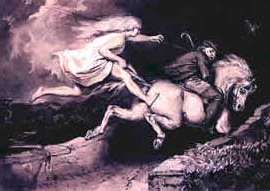
Halloween was ‘thought to be a night when Witches, Devils, and other mischief-making beings, are all abroad on their baneful midnight errands; particularly those Aerial people, the Fairies, are said on that night, to hold a grand anniversary.’ A suitable night then for the Witches Conventicle, for which Kirkyards, like the one in Alloway, were believed to be a favoured location.

Burns grew up in a rural environment hearing such tales of Witches, Ghosts, Fairies & the like; Stories & Superstitions which no doubt fed into his own Tale of Tam O’ Shanter, & his lucky escape from the ‘Hellish Legion’ of Warlocks & Witches. The mock moral of the story suggests perhaps that Tam’s supernatural experience may perhaps have had a more earthly explanation they say – The Witch in her Cutty Sark ends up with Meg the old Mares Tail severed when it crosses the ‘Brig o’er the Watter’ The inspiration for the Tea Clipper’s Name and her scantily clothed Witch Figurehead & Mares Tail
Now, do thy speedy utmost, Meg,
And win the Key-stane o’ the Brig;
There at them thou thy Tail may toss,
A running stream they dare na cross.
But ere the Key-stane she could make,
The fient a Tail she had to shake!
For Nannie, far before the rest,
Hard upon noble Maggie prest,
And flew at Tam wi’ furious ettle;
But little wist she Maggie’s mettle –
Ae Spring brought off her master hale,
But left behind her ain Gray Tail;
The Carlin claught her by the Rump,
And left poor Maggie scarce a Stump

Gallis Pole
Hangman, Hangman, upon your face a smile,
Tell me that I’m free to Ride,
Ride for many mile, mile, mile.
Oh yes, you got a fine Sister, She warmed my blood from cold,
She warmed my blood to boiling hot to keep You from the Gallows Pole,
Your brother brought me Silver, Your Sister warmed my soul,
But now I laugh and pull so hard, see you Swinging from the Gallows Pole
Swingin’ on the Gallows Pole!
Ah-ha-ha
Swingin’ Swingin’ on the Gallows Pole!
See-saw Marjory Daw
See-saw Knock at my Door
